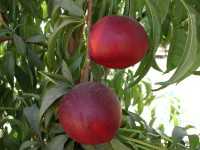California Stone Fruit Industry Holds Steady

It’s no secret there’s been quite a shake-out in the California stone fruit industry over the past decade or so. But because of new varieties, many growers are no longer down about the industry’s future. To see what might be coming in the future, we posed a set of questions to two stone fruit nursery veterans: Dale McHaley, Reedley sales manager for Dave Wilson Nursery; and Tom Burchell of Burchell Nursery. Here are their answers.
1. In general, how would you characterize the demand for stone fruit trees? Have any crops been especially hot? Cold? Any particular varieties stand out?
McHaley: In general, I would say the demand has
been steady. Nectarines have been especially hot and
apricots have been the slowest mover. Nectarines across
the board with whatever picking time is there, needs to
be filled. The nectarine Honey series from Zaiger Genetics has been very popular.
Burchell: Demand for stone fruit has dropped from the early to mid 2000s and has remained relatively low since then. We have seen a little surge in fresh-market apricots in the last two years but nothing significant. Peaches, nectarines, and plums have remained basically flat.
2. The California stone fruit industry as a whole has not had it good for several years, especially compared to the nut crops. What have you been telling growers when it comes to crop and/or variety selection?
McHaley: Over the last five years the California fruit industry has lost around 30% of its production, and most of that went into other permanent crops. The industry is now sitting in a very good position. The growers left will be in a great spot if they plant and keep a steady flow of fruit.
Burchell: The customer tells us. Since we are the only nursery with our own in-house breeding program, we have stone fruit growers coming every week to see new selections. They tell us what they are looking for. Mostly they are looking to fill a harvest time so they can have consistent picking through the summer. Occasionally they are looking for an early- or late-season fruit to capture the beginning and end of the season.
3. Smaller growers have had it particularly rough the last few years, with the most visible blow being the demise a couple years ago of the federal marketing order, the California Tree Fruit Agreement. Do you have any advice for those smaller growers who are determined to resist being swallowed up by the larger operations?
McHaley: In my opinion, the ones that are left are going to be OK. They have gone into things like organic, self marketing (farmers’ markets), and joined marketing groups with other growers their size to get market share.
Burchell: Find a niche and stick with it. We have hundreds of selections for various markets. If a small grower is interested in selling direct and flavor is the goal, then they can select a few varieties that fit the profile and plant them. It is up to the grower to develop their own market now that the federal marketing order is gone. If you are not a large company with a lot of resources, then it is very difficult to develop a market.
4. As you know, there is a trend in the U.S. called the locavore movement, in which consumers buy goods produced nearby. Obviously, this movement would take sales away from California producers in other states. Locavores extol the goodness of locally produced fruit — peaches in particular. What can California growers do to protect and/or recapture market share?
McHaley: We are very aware of this and have had growers working around this for decades. We have growers that won’t grow peaches because everyone else can. In order for us to compete we have to grow the biggest peaches, the sweetest peaches, and have the steadiest flow of peaches in the country especially for the bigger chains.
Burchell: There is a huge population that buys into that philosophy to eat locally produced fruit. Bay area residents and Los Angeles residents share that philosophy. We have a big market here already that isn’t fully tapped. Getting great-tasting fruit in front of the consumer will convince them to buy local.
5. I’m a grower who’s going to pull out an older block that isn’t making enough money and replant. Do you have any advice for me?
McHaley: To me it comes to steady flow of varieties. Labor is short and you have to keep your workers going, so if you have lapses in your schedule your workers go somewhere else. Fill in the slow spots with the best variety out there.
Burchell: Plant almonds.









